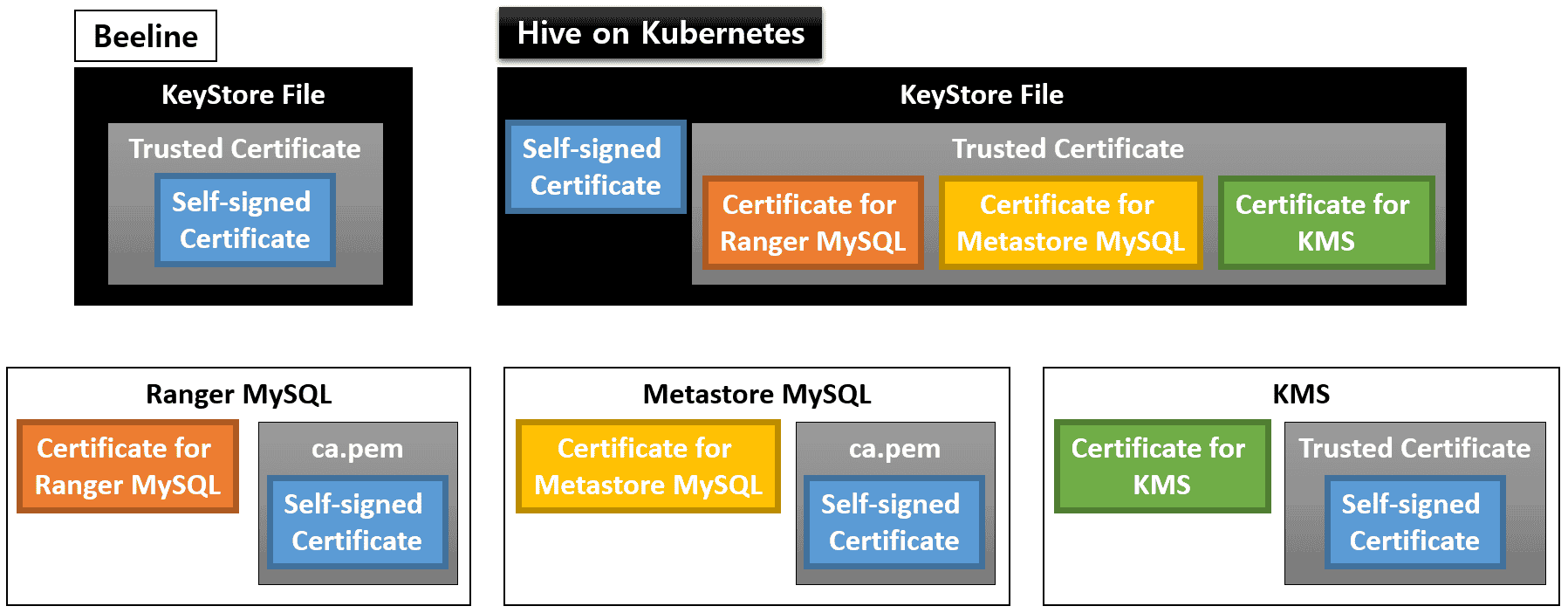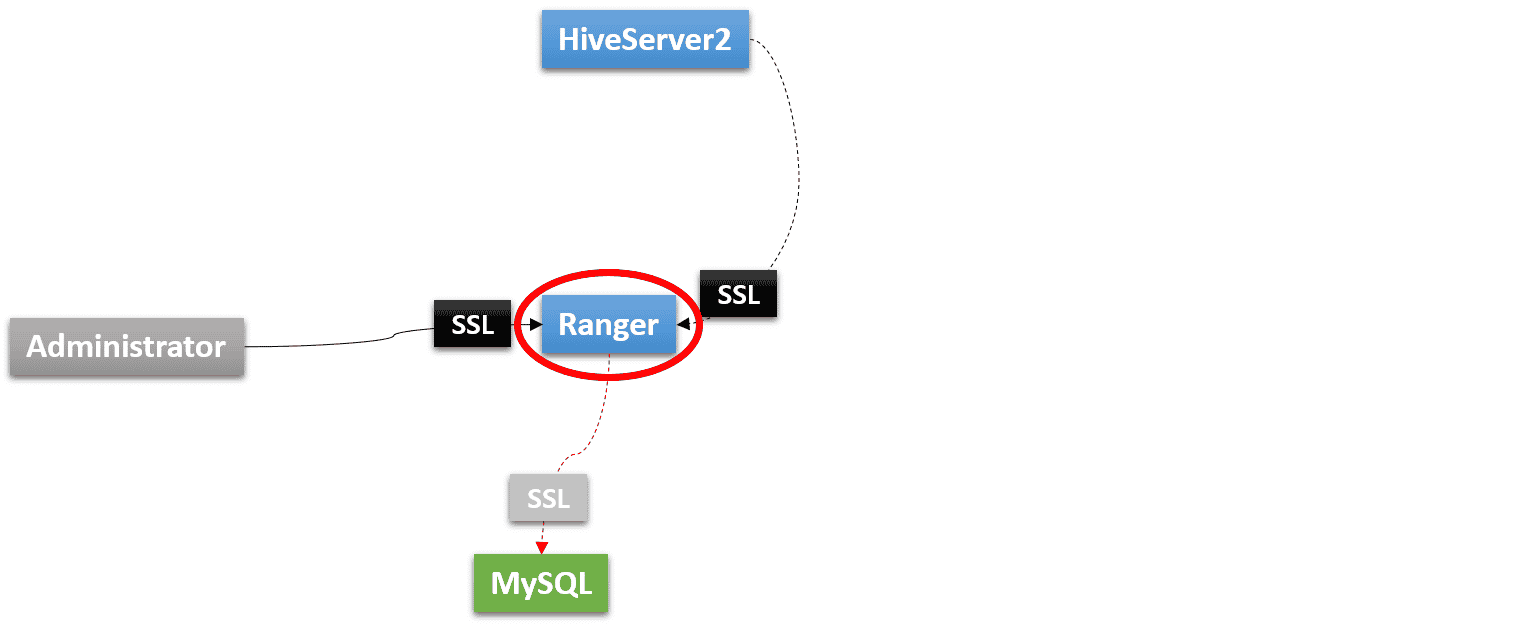Enabling SSL
Overview
In order to fully support secure communication with SSL, we need several SSL certificates.
- Self-signed SSL certificate for secure communication with internal components of Hive on MR3 (Metastore, HiveServer2, Ranger).
- SSL certificate for the MySQL database for Metastore
- SSL certificate for the MySQL database for Ranger
- SSL certificate for Hadoop KMS (Key Management Server) when using encrypted (Kerberized) HDFS
For MySQL, the SSL certificate should be provided by the administrator. If Metastore and Ranger share a common MySQL database, a single SSL certificate is enough. For the case of using encrypted HDFS, the SSL certificates for KMS should be provided by the administrator.
KMS is required only when using encrypted HDFS. When using S3 for storage, we do not need KMS.
Below we will configure SSL in a Kubernetes cluster. Kerberos KDC (Key Distribution Center) is usually part of the Hadoop cluster, but it can be located anywhere.
In order to construct the Kubernetes cluster with SSL enabled, the user needs the following certificate files:
In the end, the user will create several KeyStore files (for Beeline and all the components of Hive on MR3), and configure MySQL for Ranger, MySQL for Metastore, and KMS as depicted in the following diagram:

Here we assume that impersonation is not used, so we do not add the certificate for Metastore MySQL to the KeyStore file for KMS.
Generating a self-signed certificate
The first step is to generate a self-signed certificate for SSL.
We use the script generate-hivemr3-ssl.sh to generate a self-signed certificate.
Before executing it, the use should update config-run.sh.
- Enable SSL by setting
ENABLE_SSLandENABLE_SSL_RANGERto true. - Specify a private key KeyStore file (
mr3-ssl.jks). - Specify a credential file for the KeyStore (
mr3-ssl.jceks). - Specify the host names for HiveServer2 Service
(whose IP address is set in
yaml/hiveserver2-service.yaml), Ranger Service (whose IP address is set inyaml/ranger-service.yaml), Metastore Pod, KMS, and optionally MySQL database.
vi config-run.sh
ENABLE_SSL=true
ENABLE_SSL_RANGER=true
MR3_SSL_KEYSTORE=/home/hive/mr3/kubernetes/mr3-ssl.jks
MR3_SSL_CREDENTIAL_PROVIDER=/home/hive/mr3/kubernetes/mr3-ssl.jceks
MR3_SSL_CREDENTIAL_PROVIDER_CHECKSUM=/home/hive/mr3/kubernetes/.mr3-ssl.jceks.crc
HIVE_SERVER2_HOST=indigo20
ATS_HOST=indigo20
RANGER_HOST=indigo20
HIVE_METASTORE_HOST=hivemr3-metastore-0.metastore.hivemr3.svc.cluster.local
KMS_HOST=red0
MYSQL_HOST=red0
Note that the host name for Metastore Pod contains the namespace (hivemr3) in the middle (not in its prefix).
MR3_SSL_KEYSTORE, MR3_SSL_CREDENTIAL_PROVIDER, and MR3_SSL_CREDENTIAL_PROVIDER_CHECKSUM
must use full paths.
Before executing the script generate-hivemr3-ssl.sh,
change the Common Name for a private key KeyStore file in the function generate_keystore
so that it matches the host name in the service principal specified by HIVE_SERVER2_KERBEROS_PRINCIPAL in env.sh.
For example,
if HIVE_SERVER2_KERBEROS_PRINCIPAL is set to root/mr3@PL,
the Common Name should be set to mr3.
vi generate-hivemr3-ssl.sh
function generate_keystore {
echo -e "\n# Generating a keystore ($MR3_SSL_KEYSTORE) #" >&2
keytool -genkeypair -alias ssl-private-key -keyalg RSA -dname "CN=mr3" -keypass $PASSWORD -ext san=$SUBJECT_ALTERNATIVE_NAME -validity $VALID_DAYS -storetype jks -keystore $MR3_SSL_KEYSTORE -storepass $PASSWORD
This step is necessary in order to use a Python client for connecting to HiveServer2 that runs with SSL enabled.
Execute the script generate-hivemr3-ssl.sh to generate a private key KeyStore file and a credential file.
$ ./generate-hivemr3-ssl.sh
Generated keystore password: 4b41c3e6-7614-4d92-8a4b-d38b1a58831d
...
# Generating a keystore (/home/hive/mr3/kubernetes/mr3-ssl.jks) #
...
# Generating a credential file (/home/gla/mr3-run/kubernetes/mr3-ssl.jceks) #
...
Now the user can list three new files.
ls mr3-ssl.* .mr3-ssl.jceks.crc
.mr3-ssl.jceks.crc mr3-ssl.jceks mr3-ssl.jks
The script prints a password unique to the new KeyStore file (4b41c3e6-7614-4d92-8a4b-d38b1a58831d in the above example).
The user should set a few variables in the following files to this password.
config-run.shfor generating TrustStore filesvi config-run.sh
MR3_SSL_KEYSTORE_PASSWORD=4b41c3e6-7614-4d92-8a4b-d38b1a58831denv.shfor HiveServer2In addition, appendvi env.sh
HIVE_SERVER2_SSL_TRUSTSTOREPASS=4b41c3e6-7614-4d92-8a4b-d38b1a58831d
export HADOOP_CREDSTORE_PASSWORD=4b41c3e6-7614-4d92-8a4b-d38b1a58831dHADOOP_CREDSTORE_PASSWORDto the values of the configuration keysmr3.am.launch.envandmr3.container.launch.envinconf/mr3-site.xml. Note that for the security purpose, the user should NOT write the password itself. Just appending the string suffices because MR3 automatically sets the environment variable by reading from the system environment.vi conf/mr3-site.xml
<property>
<name>mr3.am.launch.env</name>
<value>LD_LIBRARY_PATH=$LD_LIBRARY_PATH:/opt/mr3-run/hadoop/apache-hadoop/lib/native,HADOOP_CREDSTORE_PASSWORD,AWS_ACCESS_KEY_ID,AWS_SECRET_ACCESS_KEY,AWS_REGION</value>
</property>
<property>
<name>mr3.container.launch.env</name>
<value>LD_LIBRARY_PATH=/opt/mr3-run/hadoop/apache-hadoop/lib/native,HADOOP_CREDSTORE_PASSWORD,AWS_ACCESS_KEY_ID,AWS_SECRET_ACCESS_KEY,AWS_REGION</value>
</property>ranger-key/install.propertiesfor Rangervi ranger-key/install.properties
javax_net_ssl_keyStorePassword=4b41c3e6-7614-4d92-8a4b-d38b1a58831d
javax_net_ssl_trustStorePassword=4b41c3e6-7614-4d92-8a4b-d38b1a58831dranger-key/solr.in.shfor Rangervi ranger-key/solr.in.sh
SOLR_SSL_KEY_STORE_PASSWORD=4b41c3e6-7614-4d92-8a4b-d38b1a58831d
SOLR_SSL_TRUST_STORE_PASSWORD=4b41c3e6-7614-4d92-8a4b-d38b1a58831d
Finally use the private key KeyStore file mr3-ssl.jks and the password generated by generate-hivemr3-ssl.sh
to create a new certificate file mr3-ssl.pem which can be safely distributed to all the other components.
keytool -export -keystore mr3-ssl.jks -alias ssl-private-key -file mr3-ssl.cert -storepass 4b41c3e6-7614-4d92-8a4b-d38b1a58831d
Certificate stored in file <mr3-ssl.cert>
...
openssl x509 -inform der -in mr3-ssl.cert -out mr3-ssl.pem
Ranger with SSL

Ranger does not support SSL with the default authentication.
Running Ranger with SSL has the following prerequisites.
- A MySQL database with SSL.
The MySQL database should be compatible with the MySQL connector jar file that
is specified by
HIVE_MYSQL_DRIVERinenv.sh. For the purpose of testing, the user can quickly create such a MySQL database (which automatically enables SSL) as follows:docker run -d --name mysql-server -p 3306:3306 -e MYSQL_ROOT_PASSWORD=passwd mysql:5.7 - The certificate file for connecting to the MySQL database.
Typically the certificate file is
/var/lib/mysql/ca.pemor/var/lib/mysql/ssl/ca.pemon the node where MySQL is running. - The user should be able to edit the certificate file for MySQL and restart MySQL.
Certificates for SSL
The user should make a copy of the certificate file for connecting to the MySQL database for Ranger and set MR3_RANGER_MYSQL_CERTIFICATE in config-run.sh to point to the copy.
vi config-run.sh
MR3_RANGER_MYSQL_CERTIFICATE=/home/hive/mr3/kubernetes/mr3-ranger-mysql.cert
Now Ranger is ready to connect to the MySQL database securely.
Then the user should extend the certificate file for MySQL (on the node where MySQL is running) so that MySQL can trust the self-signed certificate of Ranger.
Append the contents of mr3-ssl.pem to the certificate file for MySQL (on the node where MySQL is running).
cat >> /var/lib/mysql/ca.pem
-----BEGIN CERTIFICATE-----
MIIC4DCCAcigAwIBAgIEApwQbTANBgkqhkiG9w0BAQsFADAWMRQwEgYDVQQDEwto
...
tO1G8uO6bz/AOExeN3nrxMpuTzw=
-----END CERTIFICATE-----
Usually appending the contents of mr3-ssl.pem is necessary only for two-way authentication, but depending on the version of MySQL, it may be necessary even for one-way authentication.
Configurations for SSL
Configuring Ranger to use SSL requires the user to edit several files. The new configurations are about: 1) enabling SSL; 2) specifying the password; 3) specifying HTTPS addresses.
In ranger-key/install.properties, enable SSL.
db_ssl_auth_type can be set to 1-way in order to use one-way authentication.
audit_solr_urls should be set to the HTTPS address for Solr,
and policymgr_external_url should be set to the HTTPS address for Ranger.
vi ranger-key/install.properties
db_ssl_enabled=true
db_ssl_required=true
db_ssl_verifyServerCertificate=true
db_ssl_auth_type=2-way
audit_solr_urls=https://indigo20:6083/solr/ranger_audits
policymgr_external_url=https://indigo20:6182
policymgr_http_enabled=false
In ranger-key/solr.in.sh, enable SSL for Solr.
vi ranger-key/solr.in.sh
SOLR_SSL_ENABLED=true
SOLR_SSL_KEY_STORE=/opt/mr3-run/ranger/key/hivemr3-ssl-certificate.jks
SOLR_SSL_TRUST_STORE=/opt/mr3-run/ranger/key/hivemr3-ssl-certificate.jks
SOLR_SSL_NEED_CLIENT_AUTH=false
SOLR_SSL_WANT_CLIENT_AUTH=false
SOLR_SSL_CHECK_PEER_NAME=true
SOLR_SSL_KEY_STORE_TYPE=JKS
SOLR_SSL_TRUST_STORE_TYPE=JKS
Since Ranger now uses SSL, HiveServer2 should also be reconfigured so as to communicate with Ranger securely.
In conf/ranger-hive-security.xml, specify the HTTPS address for Ranger.
vi conf/ranger-hive-security.xml
<property>
<name>ranger.plugin.hive.policy.rest.url</name>
<value>https://indigo20:6182</value>
</property>
In conf/ranger-hive-audit.xml, specify the HTTPS address for Solr.
vi kubernetes/conf/ranger-hive-audit.xml
<property>
<name>xasecure.audit.destination.solr.urls</name>
<value>https://indigo20:6083/solr/ranger_audits</value>
</property>
Metastore with SSL
In conf/core-site.xml, the KeyStore file holding private keys should be specified.
vi conf/core-site.xml
<property>
<name>hadoop.security.credential.provider.path</name>
<value>localjceks://file/opt/mr3-run/key/hivemr3-ssl-certificate.jceks</value>
</property>
The user should make a copy of the certificate file for connecting to the MySQL database for Metastore
and set MR3_METASTORE_MYSQL_CERTIFICATE in config-run.sh to point to the copy.
vi config-run.sh
MR3_METASTORE_MYSQL_CERTIFICATE=/home/hive/mr3/kubernetes/mr3-metastore-mysql.cert
Similarly to Ranger, the user should extend the certificate file for MySQL so that MySQL can trust the self-signed certificate of Metastore.
Append the contents of mr3-ssl.pem created in the previous step to the certificate file for MySQL.
This step is unnecessary if Ranger and Metastore share the same MySQL database.
In conf/hive-site.xml,
the user specifies the URL for connecting to the MySQL database (by appending ;useSSL=true&verifyServerCertificate=true) and enables SSL.
The KeyStore file with the self-signed certificate is already specified.
vi conf/hive-site.xml
<property>
<name>javax.jdo.option.ConnectionURL</name>
<value>jdbc:mysql://${hive.database.host}/${hive.database.name}?createDatabaseIfNotExist=true&useSSL=true&verifyServerCertificate=true</value>
</property>
<property>
<name>hive.metastore.use.SSL</name>
<value>true</value>
</property>
<property>
<name>hive.metastore.keystore.path</name>
<value>/opt/mr3-run/key/hivemr3-ssl-certificate.jks</value>
</property>
<property>
<name>hive.metastore.truststore.path</name>
<value>/opt/mr3-run/key/hivemr3-ssl-certificate.jks</value>
</property>
Since we are building a Kubernetes cluster in which only Beeline (and JDBC clients) can make connections to HiveServer2 and no ordinary users can directly access the data source,
it is okay to disable security on the Metastore side and rely only on Ranger for HiveServer2.
The user can disable security on the Metastore side by unsetting the two configuration keys hive.metastore.pre.event.listeners and metastore.pre.event.listeners in conf/hive-site.xml.
vi conf/hive-site.xml
<property>
<name>hive.metastore.pre.event.listeners</name>
<value></value>
</property>
<property>
<name>metastore.pre.event.listeners</name>
<value></value>
</property>
Then the configuration key hive.security.metastore.authorization.manager is automatically ignored.
Note that Thrift Metastore URI specified by hive.metastore.uris in conf/hive-site.xml is not exposed to the outside of the Kubernetes cluster
because HIVE_METASTORE_HOST in env.sh uses the host name for the Metastore Pod.
If Thrift Metastore URI should be exposed to the outside for some reason (after introducing a Kubernetes Service),
we should enable security on the Metastore side as well.
If Thrift Metastore URI is exposed to the outside, the same Ranger instance can be used as an authorization manager for Metastore by exploiting HIVE-21753.
The user can hide the password for connecting to MySQL by updating kubernetes/mr3-ssl.jceks.
Here is an example of updating kubernetes/mr3-ssl.jceks when the password is passwd.
hadoop credential create javax.jdo.option.ConnectionPassword -provider jceks://file//home/hive/mr3/kubernetes/mr3-ssl.jceks -value passwd
javax.jdo.option.ConnectionPassword has been successfully created.
org.apache.hadoop.security.alias.JavaKeyStoreProvider has been updated.
$ keytool -list -storetype jceks -storepass none -keystore kubernetes/mr3-ssl.jceks
Keystore type: JCEKS
Keystore provider: SunJCE
...
Now the configuration key javax.jdo.option.ConnectionPassword in conf/hive-site.xml
can be set to _.
vi conf/hive-site.xml
<property>
<name>javax.jdo.option.ConnectionPassword</name>
<value>_</value>
</property>
HiveServer2 with SSL

In conf/core-site.xml, the KeyStore file holding private keys should be specified.
vi conf/core-site.xml
<property>
<name>hadoop.security.credential.provider.path</name>
<value>localjceks://file/opt/mr3-run/key/hivemr3-ssl-certificate.jceks</value>
</property>
In conf/hive-site.xml, the user enables SSL.
The KeyStore file with the self-signed certificate is already specified.
vi conf/hive-site.xml
<property>
<name>hive.server2.use.SSL</name>
<value>true</value>
</property>
<property>
<name>hive.server2.keystore.path</name>
<value>/opt/mr3-run/key/hivemr3-ssl-certificate.jks</value>
</property>
<property>
<name>hive.server2.keystore.password</name>
<value>_</value>
</property>
In order for HiveServer2 to communicate with KMS securely,
the user should make a copy of the certificate file for connecting to KMS
and set MR3_KMS_CERTIFICATE in config-run.sh to point to the copy.
vi config-run.sh
MR3_KMS_CERTIFICATE=/home/hive/mr3/kubernetes/mr3-kms.cert
In yaml/hive.yaml, the spec.hostAliases field should include the host running KMS.
vi yaml/hive.yaml
spec:
template:
spec:
hostAliases:
- ip: "10.1.91.4"
hostnames:
- "red0"
In conf/core-site.xml, the user specifies the address of KMS with SSL.
vi conf/core-site.xml
<property>
<name>dfs.encryption.key.provider.uri</name>
<value>kms://https@red0:9393/kms</value>
</property>